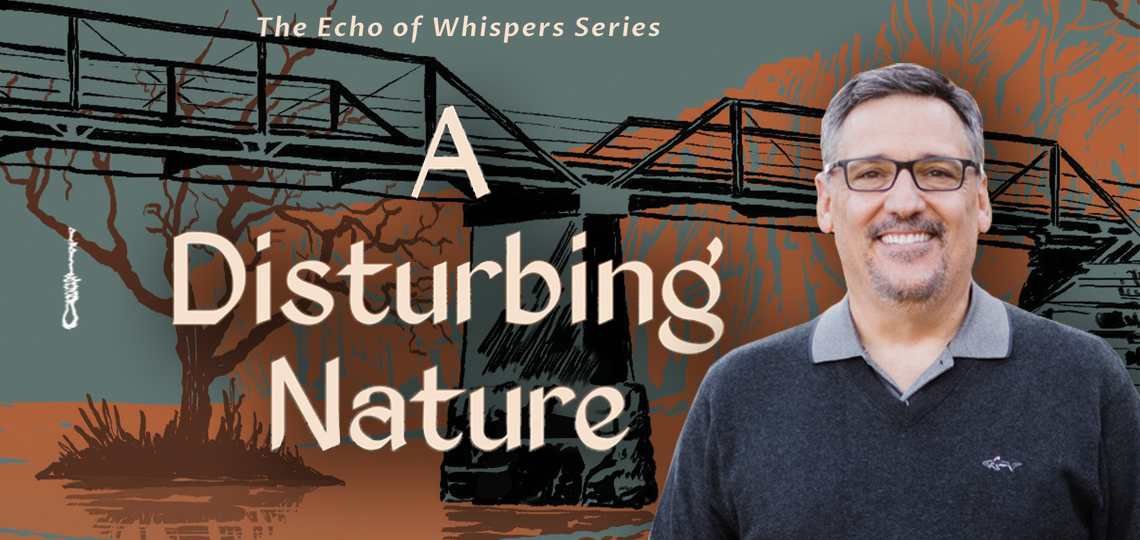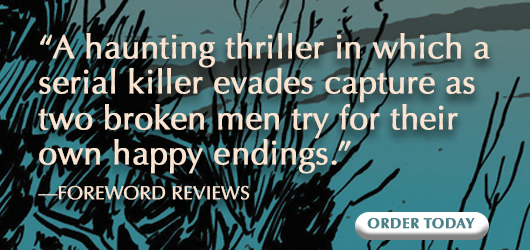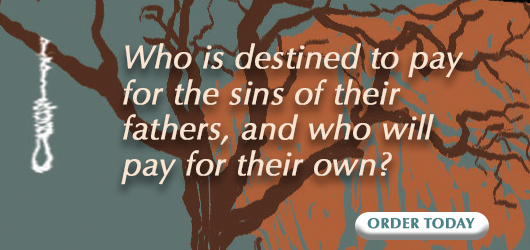Brian Lebeau discusses the monsters lurking in the darkness of his debut novel "A Disturbing Nature"

Who knows what evil lurks in the hearts of men?
Women too. And none of us can do much about it except shoo the wickedness back into the shadows when it emerges. No, we can’t control our thoughts, try as we might.
In writing his splendid new thriller, A Disturbing Nature, Brian Lebeau took a deep breath and decided to hang with his inner beast—one of those don’t-try-this-at-home leaps of faith. But he was unfazed. “Addressing intense subjects head-on required me to internalize those subjects and make them real, compelling me to face my greatest fears and look in the mirror to discover who I am and how I became that way.”
Uh, okay. We’ll take him at his word and remain comfortably in our reading chair. Foreword’s John Murray reviewed A Disturbing Nature in Foreword’s May/June 2022 issue so we pitched him with a should-you-choose-to-accept-it assignment to interview Brian and he agreed.
Enjoy!
What inspired the story? Some of the elements seem specific and personal, were they influenced by events in your own life?
The story was heavily influenced by events in my life and the constant struggle between my two competing alter egos—one version filled with childlike awe and another jaded by age and experience. A vivid dream in the spring of 1989 was the inspiration. Seminal moments from my life converged, leaving me with some tough questions and an outline for what would become A Disturbing Nature. The primary subject was a young man I traded baseball cards with between nine and eleven years old. He was a decade older, Black, and intellectually disabled due to a seizure suffered in middle school. In the dream, I recalled nasty remarks made by my other friends after I would trade cards with him at the schoolyard’s front fence. Disturbed by the alarming clarity of my dream and the recollection of spiteful words of my childhood friends, I got out of bed and jotted down several pages of notes. Over the next thirty years, the story evolved to include additional characters, a more complex plot, and increasingly dark themes.
What led to you ground most of the story in New England?
As a born-and-bred New Englander, I know the region well. Though I’ve spent the past twenty-seven years living in Virginia and California, I retain my Boston accent, continue to be a diehard Red Sox fan, and relish the area’s rich history. New England also offered a geographically removed setting distinct from FBI Chief Investigator Palmer’s most recent case—The Campus Killer, Ted Bundy—in Seattle and Utah, allowing me to distinguish The Pastoral Predator from his true-life contemporaries. It also brought Palmer full circle to his first mass murderer case—the Boston Strangler.
Finally, with the story taking place in 1975, I wanted to leverage the very real stress New Englanders endured as the Red Sox marched to the World Series and amplify it with a fictitious serial killer on the loose in the region, witnessing the competing dramas through the eyes and heart of an eleven-year-old trapped in the body of an adult.
Serial killers were a relatively new concept in the 1970s. What prompted you to set a story about “mass murderers” in that era?
I chose 1975 because that was when I turned eleven—Maurice “Mo” Lumen’s intellectual age in A Disturbing Nature. Initially, the story was entirely from Lumen’s perspective, but as FBI Chief Investigator Palmer’s role grew from an important secondary character to a primary lead in parallel with Mo, the connection to true-life crime history from that era became necessary to understand his background, motivations, and the demons he had accumulated. It’s important to note that the term “serial killer” was not coined by the FBI until the very end of the 1970s and not popularized in the media until the John Wayne Gacy trial in early 1980, so the correct 1975 term is used in A Disturbing Nature—mass murderers. Since dangerous serial offenders represent both monsters and men, and it’s safe to say nobody gets as deeply involved in hunting down the types of monsters Palmer tracks without having their view of the world altered, I thought it would be interesting to explore one hypothetical path set during America’s early peak of serial killer activity.
How and when did you get interested in researching serial killers?
Some of us have a morbid curiosity about war and death that leads us to explore history’s greatest villains and the tragedies they instigate. My fascination with true-life crime began in 1975 when I visited the Fall River Historical Society with my fifth-grade class and learned about Lizzie Borden. Over the years, I became increasingly interested in prolific mass murderers. At one end of the spectrum, serial killers litter the landscape with the inexplicable acts of deranged individuals. And at the other end, war-mongering tyrants drive troops into blood-soaked battlefields, engaging the masses with self-righteous conviction.
Arising from an interest in World War II and trying to understand the motives of despots, like Hitler, who place an alarmingly reduced value on the lives of others, I became interested in the psychology of serial killers. Though the trauma is the same for any victim’s family, the exploits of the most prolific serial killers are dwarfed by those of the most demonic despots. How would one compare Ted Bundy to Adolph Hitler?
What were some of the challenges of blending historical events and characters into your fictionalized story?
A Disturbing Nature needed to be historically and geographically accurate throughout, deviating only as necessary to support the fictional aspects of the narrative. This requirement created significant challenges concerning the timing of historical events and the parallel stories of the characters. All locations are presented as they would have looked in 1975 or earlier during their backstory, including the serial killer history discussed in the novel between 1963 and 1975. This required extensive research by the Tangent Inspired Stories team across several years and more than a half-dozen field trips to key locations in New England and Fauquier County, Virginia. Minimal artistic license was applied to support Palmer’s involvement in the Ted Bundy investigation, with all other circumstances and timelines of that case incorporated as accurately as possible. I wanted the history to be held constant while the variables surrounding a serial killer on the loose could mirror America’s broader path.
What was the biggest challenge when tackling some of the more intense elements of the story? Did you find it difficult to keep the darker aspects from affecting you in your everyday life?
Addressing intense subjects head-on required me to internalize those subjects and make them real, compelling me to face my greatest fears and look in the mirror to discover who I am and how I became that way. The desire to mask our true nature from those around us is strong, so we create barriers—alter-egos to manage the perception as separate from the reality. The most significant challenges came as I wrestled to break those walls down internally. It’s a difficult decision to display our thoughts in an uncensored way for others to judge, lest they reveal the bigotry, hypocrisy, anger, and fear that connects us all. Seeking to embrace the inner Beast and childlike awe that resides inside, and make myself vulnerable, allowed others to experience the complexity and frailty of my thoughts through Palmer and Mo.
However, it also required occasional breaks from particular scenes, contributing to an already lengthy writing period. Through these efforts, I discovered that each of us must accept ourselves as we are, and in doing so, we’ll find we’re likely no more messed up than anyone else.
Several social issues arise in the story, including mental illness and racism. How did you go about ensuring you handled the issues appropriately?
One of the many truly wonderful things arising from increased social awareness in recent years is the ready availability of professional sensitivity reviews. Through my publisher, Books Fluent, and Salt and Sage Books, A Disturbing Nature went through layers of intense review by experts to address stereotyping, politically correct terminology, and other areas that might concern readers and writers. Their efforts dramatically reduced the team’s research allocated to this critical part of the writing process and improved the story significantly.
A Disturbing Nature is the first book in the Echo of Whispers series. How many books are planned in the series, and what can readers expect in the following books?
There will be four novels in The Echo of Whispers series, and all characters from A Disturbing Nature are candidates to be explored further in subsequent books. In the second novel, An Anxious Resolution, expected to be released in 2023, we’ll follow the non-serial paths of four characters. The story will provide additional background and perspective for the first novel’s ending and move forward with Palmer. All four books were laid out during the writing of A Disturbing Nature to ensure storylines are consistent and arcs opened logically are closed summarily. Old mysteries will be solved, and new mysteries will emerge to take their place.
Along the way, Palmer and other central characters will grow, fail, and survive—at least most will. I hope that readers will enjoy the unconventional points of view in An Anxious Resolution and the use of first-person narrative in book three before settling on a surprising third-person perspective for the fourth and final book. While The Echo of Whispers series will end, FBI Chief Investigator Palmer will continue to solve major crimes and battle demons in future novels. And he will continue to evolve, as we all do.
What do you hope readers take away from A Disturbing Nature?
I hope the story of Mo Lumen and Francis Palmer will serve as a reminder of our responsibilities to one another: to the community and the planet, non-consumerism, to resist compulsive individualism and ruthlessness. With experience as a contextual background and wisdom as a guide, it is possible to interweave human dynamics and expose the delicate balance, the duality, the potential for good and evil, and the choices that build character. I hope we do not run from the demons we harbor—the beast within—but rather seek to understand them toward developing empathy for others. When we cannot forgive, we judge. And when we judge, we loosen the leash of the monster we seek to destroy.
John M. Murray



